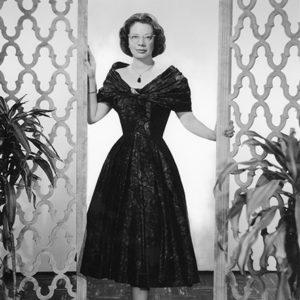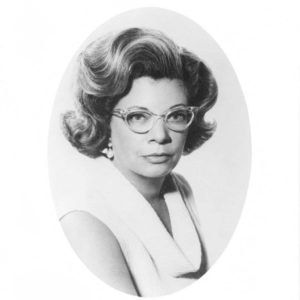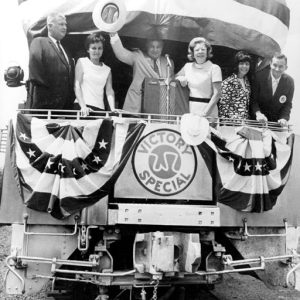calsfoundation@cals.org
Jeannette Edris Rockefeller (1918–1997)
Jeannette Edris Rockefeller was a socialite, arts promoter, and civic activist. She was first lady of Arkansas (1967–1971) during Winthrop Rockefeller’s terms as the state’s thirty-seventh governor.
Jeannette Edris was born on July 13, 1918, in Seattle, Washington, to William Edris—a high-profile capitalist of Spokane, Washington—and Frances Skinner Edris, who died during the birth of the family’s second daughter. After the death of her mother, Edris found herself under the strong influence of her grandmother, socialite Jeannette E. Skinner (her namesake), who was the wife of capitalist David Skinner, co-founder and president of Skinner & Eddy Shipyard. During her elementary school years, Edris often traveled with her grandmother to places such as Pasadena, California, and Port Maitland, British Columbia. At age twelve, she was becoming a significant societal interest, as the Seattle Daily Times society pages noted her visit to her grandparents. From 1933 onward, she remained under the press’s steady scrutiny.
In 1935, at the age of seventeen, she eloped with Nathan Barragar, a graduate of the University of Southern California and a former football player from Los Angeles, California. The marriage lasted only a few months, and the couple divorced in 1936. That same year, she enrolled in New York City’s Finch College, noted for its education and promotion of social activism for wealthy young women. She attended only the 1936 fall semester, resuming her world travels in the spring of 1937. She returned to Seattle after a summer spent in Europe and entered the University of Washington that fall.
On July 15, 1939, she interrupted her studies to marry Bruce Bartley in Seattle. The couple had two children during their six-year marriage. By the time she turned thirty-one, she was in the process of divorce from Bartley. She married for a third time in 1949 to Donald McDonnell, a graduate of the University of Washington and a vice president of Blyth and Company, Inc., a New York investment firm. However, by 1951, she had divorced McDonnell and entered into a relationship with Winthrop Rockefeller. The couple dated for five years. Rockefeller established residency in Arkansas in 1953 and divorced his first wife, Barbara “Bobo” Sears, in 1954.
On June 11, 1956, she married Rockefeller at her father’s summer home in Hayden Lake, Idaho. Shortly after their honeymoon, the couple settled at Rockefeller’s model cattle farm on Petit Jean Mountain outside of Morrilton (Conway County). According to an Arkansas Gazette article dated June 12, 1956, Jeannette Rockefeller was enthused to move to Arkansas, as she shared her husband’s interest in the state. Shortly after her move, she gave a presentation to the Fine Arts Club of Little Rock (Pulaski County) on Colonial Williamsburg in Virginia, a cultural project of Abby and John D. Rockefeller Jr.
In 1959, she increased her community involvement by co-leading, along with her husband, a successful statewide fundraising campaign for what became the Arkansas Arts Center (now the Arkansas Museum of Fine Arts). As a result of the couple’s leadership, the state raised a total of $1,500,000, which ensured the project’s success. In 1960, she assumed the role of president of the Arkansas Arts Center Board of Trustees, a position she held until 1968. During the 1960s, she served as president for the Arkansas and National Associations for Mental Health and as a trustee for the Research Foundation of the National Association for Mental Health, Inc., Finch College in New York City, and Philander Smith College in Little Rock. Finally, as first lady of Arkansas, she supervised the renovation of the Arkansas Governor’s Mansion, among other activities.
The Rockefellers’ marriage suffered under the strain of a failed third-term gubernatorial campaign and Winthrop Rockefeller’s alleged problem with alcohol. The couple divorced in 1971. Shortly thereafter, Jeannette Rockefeller established residency in Palm Springs, California, where she died on December 7, 1997. She is buried in Lake View Cemetery in Seattle.
For additional information:
Berner, Richard C. Seattle 1900–1920: From Boomtown, Urban Turbulence, to Restoration. Seattle: Charles Press, 1991.
Caillouet, Linda S. “State’s Former First Lady Rockefeller Dies at 79.” Arkansas Gazette, December 12, 1997, p. 1B, 9B.
Fine Arts Club Secretary Minutes, October 2, 1956. Arkansas Arts Center Library, Little Rock, Arkansas.
Lundgren, Kaye M. “Arts Advocate: Jeannette Edris Rockefeller and the Founding of the Arkansas Arts Center.” MA thesis, University of Arkansas at Little Rock, 2017.
“Miss Edris is Surprise Bride of Mr. Barragar.” Sunday Seattle Times, December 1, 1935.
“Miss Jeannette Edris Bartley Weds In N.Y.” Seattle Daily Times, August 2, 1949.
Saxon, Wolfgang. “Jeannette Edris Rockefeller, 79, Former First Lady of Arkansas.” New York Times, December 11, 1997.
“Society and Clubs.” Seattle Daily Times, August 10, 1930.
“Subdebs Who Enjoy Vacation.” Seattle Daily Times, August 6, 1933.
Winthrop Rockefeller Collection, 1912–1973. Center for Arkansas History and Culture. University of Arkansas at Little Rock, Little Rock, Arkansas.
“Winthrop Rockefeller Weds Jeanette [sic] Edris.” New York Times, June 12, 1956.
Kaye M. Lundgren
Little Rock, Arkansas
 Divergent Prosperity and the Arc of Reform, 1968–2022
Divergent Prosperity and the Arc of Reform, 1968–2022 Jeannette Rockefeller
Jeannette Rockefeller  Jeannette Rockefeller
Jeannette Rockefeller  Winthrop Rockefeller on Victory Train
Winthrop Rockefeller on Victory Train 




In the late 1980s, she also lived in Seattle for part of the year. She participated in philanthropic pursuits including as the president of the Board of Directors of Cornish College of the Arts. As a young staff person at Cornish, I can attest that she was a gracious and effective leader. She lived in a beautifully hidden home on the west side of Capital Hill with an amazing view.
The end of Jeannette’s life was lived in Palm Springs, but you left out the home in New York City, the last on East End Ave. There was a larger one before this, but I can’t find it, as most of the people are all gone including her nephew Jon Edris. She had a house she loved on Fire Island Pines in the ’70s and ’80s.
Even after her split with Winthrop, they would speak a couple of times a week until his death. They were very close.